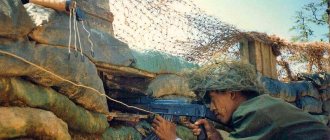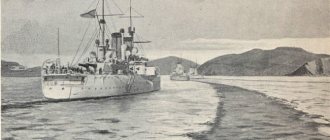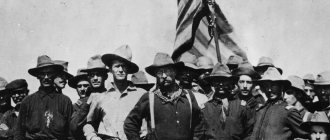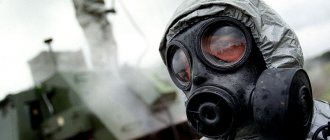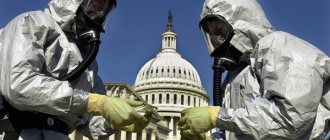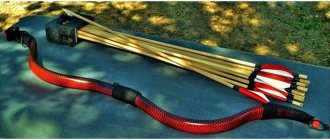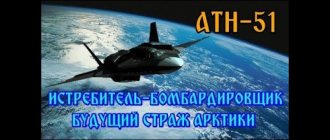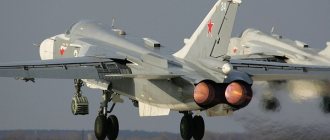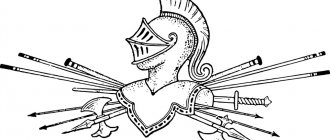Rotational dispersal aerial bomb RRAB-3.
Finland, 1939-1940 Rotary-dispersal aerial bomb (RRAB)
- a type of Soviet aviation ammunition for the mass use of small-sized aerial bombs, an early cluster bomb.
| External images | |
Device
RRAB is a thin-walled welded cylinder with head and tail fairings. The body and fairings were made of steel sheets 1 mm thick. A stabilizer consisting of four (RRAB-1 and -2) or three (RRAB-3) folding wings, also made of 1 mm thick sheet steel, mounted at an angle of 45° to the longitudinal axis of the body, was attached to the tail fairing.
The internal volume of the hull was divided by plywood partitions 10 mm thick into several compartments (maximum four compartments for RRAB-1 and -2 and three compartments for RRAB-3) depending on the type of submunition used.
“Chemical weapons - a war with one’s own people (tragic Russian experience)”
5.5. CHEMISTRY TAKES UP (end)
In addition to chemical and chemical fragmentation bombs, many other types of aerial bombs were developed: rotary, smoking, gushing,231 spraying,259 etc.
Smoking poisonous smoke bombs (CRAB) are essentially analogues of POISON checkers. They were intended to create poisonous waves by serial bombing from an aircraft behind enemy lines[291]. Testing of CRABs began in 1932 at the TsVHP in Shikhany. Over 5 years, several modifications of bombs were tested, including KRAB-25[230], KRAB-50[230], KRAB-200[291]. Bomb casings were manufactured at plant No. 67, equipment was manufactured at plant No. 12 (Elektrostal). The smoke mixture was based on adamsite, the production of which was established at plant No. 51 (Moscow). The best combat effect was shown by the KRAB-25 bomb (the weight of the poison mixture is 7–8 kg). The covering power of the poison wave remained up to 500 m, and its penetration depth was 6–7 km. The poison wave from 8 bombs at a distance of 250–500 m caused moderate and mild irritation of the respiratory system and mild irritation of the eyes. Only the KRAB-25 bomb could be used in RRAB cluster bombs[291]. Summer tests of KRAB-50 were carried out in 1934 at the TsVKhP with bombing from altitudes up to 4000 m, winter tests - in 1935. The weight of the poisonous mixture was 17-18 kg. With the simultaneous action of 7 bombs, strong irritation persisted at a distance of up to 500 m, medium degree - up to 1000 m. On the need to adopt the CRAB-50 into service, the head of VOKHIMU Y.M. Fishman reported to the People's Commissar of Defense in 1935[84]. The KRAB-200 bomb contained 63 kg of poisonous mixture. The depth of penetration of a clearly visible wave from two simultaneously operating bombs reached 3–5 km (its width at a distance of 1000 m reached 100–120 m)[291]. It was believed that CRABs would be a powerful means of constraining the actions of enemy troops and fire weapons at distances of up to 5–6 km, at which the irritating effect of the wave persists. It was also supposed to combine CRABs with chemical, chemical fragmentation and high-explosive bombs. Military tests of the KRAB-25 and KRAB-50 were planned for the summer of 1938 - the best model was to be adopted by the army[291]. In fact, only the KRAB-25YAD bomb was in service, however, it was also excluded from the chemical weapons system in 1940 as “unsatisfactory in its tactical and technical properties.”
In parallel with aerial chemical bombs, work was carried out to create various types of batch and cassette devices .
Rotational dispersal aircraft bombs (RRAB) appeared in the Red Army in the early 30s. They were intended for simultaneous and massive destruction of large areas and objects with packages of aerochemical and other bombs of various calibers[229]. The first RRAB bomb of the S. Lvov-V. Chernyaev system was adopted by the USSR RVS for service with the Air Force on December 11, 1932[84]. And in the summer of 1934, military tests of three types of RRAB bombs took place at the Shikhany training ground[229]. These were large devices that could accommodate large series of inserted bombs of various types - AOX-8, AOX-10, AKHB-25 and KRAB-25, etc. After being dropped from an airplane, the RRABs (three variants of these shells were considered) received a rotational movement, during which the constricting rings were torn and the insert bombs scattered to the sides. When bombing from a height of up to 2000 m with one RRAB, the area of chemical damage ranged from 7 to 11 hectares[291].
Table 5.7 contains data on RRAB type bombs of the pre-war years.
Table 5.7
Rotational dispersal bombs291
| Model | RRAB-250 | RRAB-500 | RRAB-1000 |
| Length, mm | 2308 | 3270 | 3867 |
| Working capacity, l | 301,5 | 628,0 | 1134,0 |
| Total weight, kg | 67 | 106 | 160 |
| Number of aviation chemical bombs in one cassette: | |||
| AOX-8 | 31 | 100 | 111 |
| AOX-10 | 48 | 110 | 120 |
| AKhB-25 | 20 | ||
| CRAB-25 | 14 |
The RRAB-500 shell was considered the most effective, and the greatest combat effect was achieved when filling the RRAB with small-sized fragmentation chemical bombs[291]. However, only two models were included in the chemical weapons system of 1940 - RRAB-3 (RRAB-250) and RRAB-2 (RRAB-500).
The first ampoule bomb cluster ABK-1 was intended for dropping round ampoules filled with chemical agents from any height and at any speed of an SB aircraft. The goal was to contaminate the SOW area and defeat the enemy SOW and NV troops. The ABK-1 cassette began to be produced serially in 1938. The ABK-3 cassette of a similar purpose passed field tests in 1940 (it was intended to be dropped from DB-3, DB-ZF, etc. aircraft). As part of the ABK-1 and ABK-3 cassettes, round ampoules of two types were dropped - with a diameter of 125 mm (ampule AZh-2 with a working volume for OM of 0.82 l and a loaded weight of 1.27 kg, its mass production began in 1936 g) and 260 mm (working volume 8 l, loaded weight 13.7 kg, field tests were carried out in 1940). When reaching the surface of the earth, the AZH-2 ampoules burst at the solder seams, and the ampoules with a diameter of 260 mm were equipped with a fuse. One ABK-1 cassette contained 30 AZH-2 ampoules (25 l of OM) or 4 ampoules with a diameter of 260 mm (32 l). One ABK-3 cassette contained 120 AZH-2 ampoules (100 l of OM) or 16 ampoules with a diameter of 260 mm (130 l of OM). In addition, in 1940, ampoules with a fuse and a diameter of 113 mm (working capacity 0.78 l) were tested. In the same year, a chemical weapons system was adopted, which included, among other things, a one-liter chemical ampoule.
In addition to chemical bombs and cassettes, at the instigation of the German army (and Soviet military intelligence), active work was underway on the creation of VAPs and UHAPs (pouring and universal chemical aviation devices)[239,272,274]. These metal tanks for pouring out chemical agents from various heights were intended to destroy the enemy's railways with SOV and NV and contaminate the area with SOV in a liquid state. The methods of pouring out the OM from the aircraft device were different - either freely (VAPy)[272] or with additional pressure (UHAPy)[239]. However, the path to creating this means of aerial agent spraying turned out to be particularly difficult.
Many armies of the world began to arm their aircraft with VAPs soon after the end of the World War. In the first half of 1925, detailed data on the German VAP were obtained by Ya.M. Fishman, at that time the Soviet military attaché in Germany. Having become the head of VOKHIMU, Y.M. Fishman organized joint tests of the German VAP at the end of 1926 at the Kuzminki test site (Moscow), which turned out to be successful. New models of German VAPs were also successfully tested in 1927–1928. in Orenburg[673] and in Shikhany (Saratov region). Although German specialists handed over all samples and documents for VAPs to the Red Army, the construction of Soviet models based on them was difficult. The first copied sample of VAP-1 (capacity - 80 liters of NOV or mustard gas; a set of two devices was intended for installation on the P1 reconnaissance aircraft; agent pouring height - 25–100 m) constantly gave out operational failures. In addition, a lot of chemical agents returned to the airfield and contaminated it. The new model of 1928, VAP-2, which had the same characteristics as VAP-1, but a different design of the pour hole, was equally unsuccessful.
FROM THE MINUTES OF THE MEETING OF THE SCIENTIFIC COUNCIL OF THE RKKA IKh No. 4 OF MARCH 9, 1929: “t. Lipin. The next item is the VAP-2 device.
T. Fishman. Tests of old-design VAP devices were carried out at the training ground, and the results were positive... Consider the tactical suitability and value of the VAP device as proven, and consider the experience at the Kyiv maneuvers reliable for this. Prepare a prototype no later than 1/IV and no later than 15/V submit the VAP in its finished form to the Revolutionary Military Council..."
In the fall of 1929, during all-Union maneuvers in the BVI, military tests of VAP-3 (NOV or mustard gas; the height of the agent pouring out was 25–100 m) were carried out, and they did not satisfy the specialists. There was another series of VAP samples (VAP-K-1,2,3). In general, all these models copied German models, but were adapted for placement on types of aircraft other than German ones. In addition, Soviet VAPs “splashed abundantly on the fuselage, planes and stabilizer of the OV aircraft.” Only the next model VAP-4 successfully passed the tests in 1930. This time it was possible to find an acceptable solution for the design of the overflow hole[228]. And by the decision of December 17, 1930, the Revolutionary Military Council of the USSR adopted the VAP-4 device for aviation service, intended for “defeating enemy personnel with combat weapons: on the march, on vacation, in the deep rear, during landings, etc.”[79]. However, field tests of this device continued at the TsVKhP until 1937. Both ordinary sulfur mustard and mixtures of SOM (mustard-lewisite, mustard-propyl mustard, mustard-diphosgene, etc.) and various NOM (phosgene, diphosgene, hydrocyanic acid) were tested. acid) from low level flight. It was with the use of VAP-4 that tasks such as infecting an airfield, as well as defeating an enemy in a populated area, were practiced at the TsVHP in Shikhany.
Table 5.8 shows the main models of pour-out chemical instruments and devices developed in the pre-war years for the Red Army Air Force.
Table 5.8
Pre-war aircraft pour-out instruments of the Soviet Air Force289,290
| Model | Working capacity, l | Weight, kg | Aircraft (set) | Time howled- vania | Serial production quality | |
| Empty _ | Snarya- married | |||||
| Airborne pour-out devices (VAP) | ||||||
| VAP-1 | 80 | 12 | 119,5 | R-1 (2) | 9 | |
| VAP-2 | 80 | 14 | 107,6 | R-1 (2) | 7 | |
| VAP-3 | 70 | 16 | 100,5 | R-1 (2) | 7 | |
| VAP-4 | 80-85 | 17,6 | 120 | R-5 (4) | 6 | |
| MBR-4 (2) | 5 — 6 | |||||
| VAP-5 | 160 | 38,0 | 238 | R-5 (2) | 6 — 7 | |
| VAP-6 | 39,5 | 8,65 | 60 | I-5 (2) | 3,5 — 4 | 1935 |
| VAP-6M (VAP-50) | 39 | 60 | 3 — 4 | 1937 | ||
| Himbak | 350 | 89 | 455 | TB-1 (2) | 3 — 5 | |
| VAP-200 | 127 | 35 | 200 | BS-1, BS-2… | 3–4 | 1939 |
| VAP-500 | 350 | 100 | 506 | TB-3 (4) | 4–5 | 1936 |
| VAP-1000 | 630 | 200 | 1040 | TB-3 (2) | 5–6 | 1937 |
| Universal chemical aviation instruments (UCAP) | ||||||
| UKAP-250 | 95 | 100 | 276 | BS-1, BS-2… | ||
| UKAP-500 | 190–192 | 125 | 500 | SB, DB-3... | 1939 | |
| Chemical aviation disposable devices (HARP) | ||||||
| HARP-500 | 209 | 66 | 340 | SB, DB-3... | — | 1940 |
Initially, a set of two VAP-4 was intended for armament of the R-1 and M-5 aircraft; it made it possible to infect an area of 3 to 50 hectares with SWS from heights from 20 to 600 m with an infection density of 0.5–3.2 g/m2. On the R-5 reconnaissance aircraft, 4 VAP-4 devices were installed (total weight of the explosive agent - 408 kg), and on the MBR-4 - 2 (total weight of the explosive agent - 204 kg). In general, VAP-4 devices were equipped with attack group aircraft (R-5, MBR-2 and MBR-4, Savoy, SSS, RZ, LR, etc.), and they made it possible to pour out chemical agents up to altitudes of 2000–4000 m. VAP-5 and VAP-6 completed a series of low-volume devices. The VAP-5 device had the same purpose as the VAP-4. It turned out to be passable (one field test was completed) and was not included in the combat formation. But the VAP-6 device (Leningrad) left a noticeable mark on the military-chemical history of aviation. Two VAP-6 (filling - NOV or mustard gas, total amount of OM - 103 kg, infection area - 1.8 hectares) were intended to be installed first on I-5 fighters, and then on other fighters - I-15 bis[276], I-16P, I-153[255] and others.
The next stage in aviation chemical weapons was the creation of a series of high-capacity VAP, UHAP and HARP devices, intended for installation on heavy chemical aircraft. These devices already took into account the level that anti-aircraft artillery had reached in the armies of the world in the mid-30s. — to carry out chemical attacks it was necessary to go to high altitudes. In addition, these devices made it possible to use OM more economically: the efficiency of OM use in devices (for VAP-500 - 82%, for HARP-500 - 81.9%, for UKAP-500 - 72.4%) was higher than for chemical bombs KHAB-500 (62%).
The first tests of VAP-500 devices were carried out at TsVKhP in 1935 and 1936. Pouring mustard gas from a height of 500 m “provided valuable results and fully allowed us to draw a conclusion about the toxic effectiveness of mustard gas under these conditions.” The next experiment took place on September 11, 1937. On that day, 1200 kg of mustard gas were poured onto the experimental field of the TsVHP from a height of 200 m from a DB-3 aircraft, contaminating an area of 40.7 hectares with a density of 11.6–12.4 g/m2. All 15 dogs were affected, 9 of them died, and the rest were seriously injured. Based on the test results, it was decided to install a set of 4 VAP-500 devices on TB-3 bombers. They were also equipped with DB-2, SB, DB-3 and other aircraft. With the help of the VAP-500, it was planned to carry out the pouring of SOV from combat heights (5–8 km) in order to infect large areas to exhaust the enemy. With the massive use of SDS from high altitudes, the creators of the VAP-500 hoped to provide a combined defeat of the enemy’s tanks: directly from droplet-liquid agents, as well as from contact with contaminated terrain. The working volume of the cylinder in the VAP-500 device was 315 l, the weight of the SOV was 406 kg, the weight of the empty device was 100 kg, and the liquid flow time was 4–5 seconds. When pouring mustard gas from VAP-500, Soviet military leaders received encouraging results: skin damage in 100% of cases, eye damage in 46%, respiratory damage in 25%. The development of VAP-500 continued after the start of its mass production[256,257].
The VAP-1000 device had the same purpose as the VAP-500. It was also supposed to be installed on chemical bombers TB-3, DB-2, etc. If 810 kg of mustard gas were poured from a height of 700 m, contamination of 80 hectares would be ensured. In addition to VAP-500 and VAP-1000, an intermediate type device, VAP-200, was also tested. The first field tests of the universal aircraft device UKhAP-500 developed by TsAGI, the pouring out of which was ensured by the pressure of powder gases (8–12 atm.), began back in 1935. Military tests were completed in 1939[239]. The device was intended to destroy enemy tanks and contaminate the area. They were armed with attack aircraft and bombers SB, DB-3, MBR-6, etc. And in 1940, the UKAP-250 device was tested (for arming the aircraft BSh-1, BSh-2, MBR-2, etc.).
In the second half of the 30s. The question inevitably arose about the division of labor between the aircraft and the chemical pouring device . The newest heavy and high-speed aircraft, driven by the successes of anti-aircraft artillery to fairly high altitudes, were essentially no longer able to produce sufficiently targeted watering of chemical agents. And inevitably the question arose about transferring the ideology of using remote-type chemical munitions - bombs and shells - to pour-out chemical devices. Within its framework, the aircraft had to continue to operate at high altitudes and high speeds, and the chemical attack could be carried out by drop devices, which were to be opened at the optimal altitude and carry out chemical destruction of ground targets independently of the aircraft. Thus, pour-out aircraft chemical devices became as disposable as chemical bombs and chemical shells.
Socialist competition developed in the practical work of designing disposable chemical pour-out devices intended to destroy enemy SOV and NVS from high-speed aircraft, as well as contaminate the area of the SOV. Chemical aviation disposable devices of the HARP series [273] designed by plant No. 145, as well as remote chemical devices of the DKhP series designed by the TsAGI Institute, entered the arena.
The HARP-500 device could be dropped from an airplane from high altitudes, and its opening by the force of powder gases should have occurred at an altitude convenient for a chemical attack. This device was first tested in July 1938, and it showed “fail-safe operation and a satisfactory combat effect with SOV for defeating manpower.” Field tests in 1939 in Shikhany led to the conclusion that it could be recommended for military testing when equipped with cotton swabs impregnated with SOV. The device was installed on both chemical attack aircraft and bombers (SB, DB-3, etc.)[243].
It remains to add that from the rich variety of models of pouring devices, only the most effective ones were included in the chemical weapons system of 1940 - VAP-500, VAP-200 and VAP-6, which were already in service, as well as UKAP-500[239], which was to be enter into service with the Red Army Air Force.
In connection with the creation of pouring devices for large volumes of chemical agents, special mention should be made of the long-standing dream of the Red Army command to learn how to use chemical agents from high altitudes , that is, in essence, to learn an aerial chemical attack from an ambush.
Back on December 19, 1931, in the decree of the Revolutionary Military Council of the USSR “On the State of Invention,” it was decided to “achieve in 1932 the spraying of liquid chemical agents from a height of 5000 m”[204]. And in the future, such decisions were made more than once, but it took time for the conditions to mature for their implementation.
The dream of high-altitude chemical spills was realized only in the fall of 1938, when, by order of the Defense Department under the Council of People's Commissars of the USSR, special aerial chemical exercises were finally held in the Central Asian Military District (SAVO) on the use of new methods of aerial chemical attack[349]. It was in a world open to all Soviet citizens that on September 11, 1938, the beautiful Mayakovskaya metro station was opened in Moscow. And on September 19, 1938, the Pravda newspaper completed the publication of a book entitled “History of the All-Union Communist Party (Bolsheviks): a short course. Approved by the Central Committee of the All-Union Communist Party (Bolsheviks)”, which recorded the false history of the country for many decades. Meanwhile, the Red Army was writing a completely different story, which we do not know about to this day. Aviation chemical exercises took place between October 11 and November 10, 1938 in the Hungry Steppe on the border of Uzbekistan and Kazakhstan[350].
Experiments on pouring SOWs from very high altitudes were carried out by three TsKB-30 (DB-3) aircraft, armed with three VAP-500s each, and two TB-3 RN aircraft, armed with three VAP-1000s each. A total of 15 experiments were carried out on pouring various SDS formulations (mustard gas, a mixture of mustard gas with dichloroethane, and a mixture of mustard gas with lewisite) from altitudes of 2000, 4000, 5000, 6000, 7000 and 7600 m. The conclusion of the exercise organizers: “As a result of the experiments carried out on pouring OWL... it has been proven that high-altitude pouring is one of the powerful methods of airborne chemical attack. During high-altitude spills of WDS, enormous areas are contaminated, measured in tens of square kilometers (10–25 km for the TsKB-30 unit)”[350].
The ability to hit large areas from altitudes of 5–8 km impressed the Air Force command so much that in 1939 the tasks of testing the operational-tactical use of SOWs from high altitudes were given to the aviation forces of all military districts of the country[246].
Another and very serious impetus for the development of chemical attack weapons in aviation was given by the decision of the Military Council of the Red Army Air Force of January 31, 1939 to raise the level of chemical training of the Air Force[135]. It was established that the tactical and technical requirements for all new military aircraft must include chemical weapons, and it was decided to test new aircraft simultaneously with testing their chemical equipment. It was also decided that half of the country’s aircraft (attack, military, light bomber) should be armed with chemical VAPs.
In the same document, it was decided to raise before the General Staff of the Red Army the question of assigning to the Air Force a plot of land of 80x80 km2 for the creation of a special Aviation Chemical Test Site (ACS) for conducting experiments and exercises on the use of chemical warfare agents by aviation from any heights under any weather conditions (pouring SOV from high altitudes, bombing of large-caliber chemical air bombs from altitudes of more than 500 m, launching waves of non-propellant bombs, combat training of chemical aviation regiments)[135]. The idea was implemented within Stakhanov’s time[172], and large-scale specialized aviation chemical exercises at the newly opened training ground in the Uralsk region (Kazakhstan) took place between August 5 and September 28, 1940. The participants were “chemical” air regiments (16 SBP, 48 SBP and 50 SBP). Experiments on the use of IDS included bombing KHAB-200, pouring from an altitude of 6000 m, etc.[359]
In general, before the start of the Great War, Soviet chemical weapons were firmly in place[260].
Dream L.D. Trotsky's idea of crossing chemistry with aviation was actively pursued. The baptism of fire of chemicalized aviation units took place in the fall of 1928 during all-Union maneuvers in the Kiev region. It was then, or more precisely, on September 12, that a detachment of 5 aircraft from the chemical squadron of the 5th air brigade “raided the territory of the Kiev-passenger station (depot, main workshops and station).” In the report that was presented by I.S. Unshlikht and S.S. Kamenev, based on the results of that raid, the head of VOKHIMU was optimistic: “the great importance of spraying mustard gas from aircraft as a powerful means for inflicting direct losses on troops was fully revealed”[301]. Already in 1931 Ya.M. Fishman declared that “the issue of chemicalization of the air fleet is moving to the forefront.” And he not only declared, but also actively acted. In the 1931 directory, the power of the attack squadron, which consisted of P-5 aircraft and was armed with VAP-4 devices, was as follows. It could hit an enemy column 3 km long and about 500 m wide with an average density of 10 g/m2, or 6 km long and 500 m wide with a density of 5 g/m2. Two such squadrons could be used to destroy combat formations of a rifle division (total damage area - 3 km2 with a density of 10 g/m2 or 6 km2 with a density of 5 g/m2). And a squadron of light bombers could deliver 19.5 tons of AX-25 bombs in one flight, ensuring a destruction of 0.5 km2 with a density of COW of approximately 15 g/m2.
The formation and reorganization of chemical aviation units proceeded continuously, and this was associated with the active development of aviation chemical weapons. The appearance of the aerochemical strike force is associated with the directive of the Chief of the General Staff of the Red Army A.I. Egorov dated March 23, 1936 on the allocation within the Red Army Air Force of a group of air brigades specialized in the widespread use of chemical weapons - 109 attack air brigade (ShAB, Chita), 44 ShAB (Krasnoyarsk), 100 ShAB (Detskoe Selo, later Pushkin; aircraft SSS), 81 ShAB (Kiev, SSS aircraft), 114 ShAB (Gomel, SSS aircraft), 16 TAB (Poltava, TB-3 M-17 aircraft), 19 TAB (Ivanovo, TB-3 M-17 aircraft). And on August 5, 1938, another directive from the Chief of the General Staff was issued on the allocation of an even larger number of assault and bomber aviation regiments for the use of chemical weapons (pouring SOWs and NOVs from VAPs, ampoule throwing and bombing with aerial chemical bombs). In November 1939, the General Staff designated another 10 attack and bomber air regiments “as chemicalized to perform special chemical tasks and acquire practical skills in the use of chemical weapons”[246].
Corresponding changes took place in the aviation training system. In 1936, the 81st, 100th, 109th and 114th chemical attack air brigades mastered the high-altitude pouring of chemical agents.
At the turn of 1936–1937 The role of aviation chemical weapons in the Red Army increased so much that they began to be considered not a tactical, but an operational factor . Assessments of the chemical training of the Red Army Air Force were also carried out[334]. In 1937, the People's Commissar of Defense, by order No. 00107, set the task for all Air Forces to make chemical training one of the main types of special training. In particular, bomber aviation was ordered to master the art of using explosive agents from high altitudes. In pursuance of this, the Air Force was ordered to conduct 10% of all sorties during tactical flight exercises with the use of chemical weapons[338]. Special instructions were developed for preparing airfields for the departure of aircraft with VAPs[341]. And at the end of 1937, the Air Force summed up the results of chemical training[335]. In 1939, numerous chemicalized air regiments received a wide range of tasks to master the tactics and techniques of using all types of aviation chemical weapons at any altitude: pouring SOV and NOV from VAPs, ampoule throwing, bombing. In addition, they were instructed to “master the use of airborne weapons against air targets”[246]. However, aviation management was not satisfied with the state of affairs. In this regard, in the order of the head of the Red Army Air Force dated June 15, 1940 “On increasing the chemical training of units of the Red Army Air Force”[363], the lag of aviation units in chemical training was again noted. As a negative example, it was pointed out that before the start of the war with Finland, aviation units arrived at the front without chemical weapons.
Development of aviation technology for chemical attack, successes of military exercises and tests in 1938–1940. were accompanied by a fundamental increase in the status of the military chemical service in aviation . And this was reflected in the “Regulations on the Headquarters of the Red Army Air Force,” which on September 10, 1940 was approved by the new head of the Main Directorate of the Red Army Air Force, General P.V. Leverages. Among the main departments, without which any headquarters cannot do (operational, communications, organizational-mobilization, logistics), there was also... chemical, although previously it was only an ordinary unit of one of the departments. The head of the chemical service department of the Air Force headquarters simultaneously became the head of the chemical service of the Red Army Air Force. The newly created department was entrusted with serious tasks: development of a chemical weapons system and issues of combat use of chemical attack weapons, participation in military testing of new types of chemical weapons and conducting experimental exercises on the use of chemical weapons, management of the training of special chemical units of the Air Force, participation in the development of new types of weapons chemical attack and means of defense...
The seriousness of the status of chemical weapons in the Air Force that developed in those years was especially clearly manifested in the order of the commander of the Air Force II OKA P.F. Zhigarev (1900–1963) No. 0023, signed on July 27, 1939 after a directive from Moscow. At the beginning of it, the future Chief Marshal of Aviation of the USSR emotionally stated that “many commanders and commissars have not yet understood that personal skill and instructor skills in the combat use of chemical agents raise the authority of the command and control personnel of the Air Force in the eyes of subordinates.” And in the final part it came to orders that reflected the real status of chemical weapons. All units of the II OKA Air Force were ordered “when performing exercises in the air to be guided by the following standards of weapons and sorties with chemical weapons”: fighter aircraft - 5%, military and long-range bomber aircraft - 10%, short-range bomber aircraft - 20%, attack aircraft - 30%. Let’s not be mistaken - these percentages were not A.F.’s personal initiative. Zhigarev, but a consequence of a general trend. To confirm this, we will indicate what numbers the head of the Red Army Air Force A.D. used. Loktionov (1893–1941), submitting to the Chief of the General Staff, Marshal B.M. Shaposhnikov (1882–1945) “Mobilization request of the Red Army Air Force management for military equipment and weapons for 1940 in wartime”[110]. In that document, which was once classified as “top secret of special importance,” aviation planned to use quite a lot of chemicals during the war year: 60 thousand tons of SOW and 18 thousand tons of NOV.
The number of sorties with VAPs by aircraft of chemically modified air units was planned as follows: for DB-3 bombers - 75% of the total number of sorties, for BB-2, I-153 and I-180 attack aircraft - 62% each. And this was no exception - military (non-chemical) air units planned to use chemical weapons just as actively: the number of sorties with VAPs for SB light bombers and BB-22 short-range bombers should have been at least 20% of the total number of sorties, for I-153 attack aircraft - at least 30%, for I-153 and I-180 fighters - at least 10%, for TB-7 and DB-3 bombers - at least 10%[110]. At the end of 1938, things came to the establishment of standards for arming new aircraft with chemical devices, so that aircraft would be equipped with VAPs already at the time of their production at aircraft factories[246]. The numbers turned out to be impressive: heavy, medium and long-range bombers had to be 1/3 adapted for the use of VAPs, light bombers and military aircraft - half, attack aircraft and fighters - 1/5.
A definite result of all that activity in preparing for a chemical attack by aviation means were the NPO orders of February 15, 1939: top secret order No. 007[101] and secret order No. 023[102] (two orders because their readers had different degrees "admission" to secrets). In them, Marshal K.E. Voroshilov meticulously listed all the types of aircraft at his disposal and the types of chemical weapons that could be used with their help. It should be emphasized that the order of 1939[101] seriously enriched in comparison with a similar document of 1936[100].
Let us present these data so that we can assess the scale of what has been achieved (the minimum altitude for the use of all chemical and fragmentation-chemical aerial bombs was the same - 300 m for targets on land and on water):
•• the TB-3 heavy bomber (modifications 4M17 or 4M34) had a bomb load of 2000 kg and could use 26 KHAB-25 chemical bombs (SOV equipment), or 26 KRAB-25YAD smoking chemical bombs, or 4 KHAB-200 bombs ( equipment - SOV or NOV), or 4 KHAB-500 (NOV) bombs[251];
•• long-range bomber DB-3 (modification 4M34R) had a bomb load of 1000 kg and could carry 10 KHAB-25 bombs, or 10 KRAB-25YAD bombs, or 3 KHAB-200 bombs, or 3 KHAB-500 bombs[236,251,252];
•• the SB-2M-100 medium bomber with a bomb load of 600 kg could carry 6 KHAB-25 bombs, or 6 KRAB-25YAD bombs, or 24 AOX-8 fragmentation chemical bombs (in the form of a cassette), or 24 AOX-10 bombs (in the form of a cassette)[233,253];
•• medium bomber SB-2M-100 (modernized) with a load of 600 kg could carry 2 KHAB-200 bombs or 2 KHAB-500 bombs[233,253];
•• heavy bomber TB-1 (modification 2M17) with a bomb load of 1000 kg could carry 6 KHAB-200 bombs;
•• reconnaissance R-5 (modification M17) had a bomb load of 300–500 kg and could carry 8 AOX-8 bombs, or 8 AOX-10 bombs, or 8 KHAB-25 bombs, or 8 KRAB-25YAD bombs, or 2 bombs KHAB-200;
•• the R-6 reconnaissance aircraft (modification 2M17) had a bomb load of 192 kg and could carry 6 AOX-8 bombs, or 6 AOX-10 bombs, or 4 KHAB-25 bombs, or 4 KRAB-25YAD bombs;
•• the R-zet aircraft (modification M34) had a bomb load of 300–500 kg and could carry 8 AOX-8 bombs, or 8 AOX-10 bombs, or 8 KHAB-25 bombs, or 8 KRAB-25YAD bombs, or 2 bombs KHAB-200;
•• the SSS aircraft (modification M17) could have a bomb load from 370 to 800 kg and carry 20 AOX-8 bombs, or 20 AOX-10 bombs, or 4 KHAB-25 bombs;
•• the R-10 reconnaissance aircraft had a bomb load of 200 kg and could carry 10 AOX-8 bombs, or 10 AOX-10 bombs, or 6 KHAB-25 bombs, or 6 KRAB-25YAD bombs;
•• the DI-6275 fighter (modification M25B) had a bomb load of 40 kg and could carry 4 AOX-8 bombs or 4 AOX-10 bombs;
•• the I-15 Bis fighter (modification M25) had a bomb load of 40 kg and could carry 2 AOX-8 bombs, or 2 AOX-10 bombs, or 2 KHAB-25 bombs, or 2 KRAB-25YAD bombs[234,254,276].
In previous years, aviation chemical ammunition was stored in artillery warehouses. However, at the end of the 30s. The aviation sector developed in the Red Army to such an extent that specialized aviation weapons warehouses appeared, containing departments of chemical ammunition.
Data on some of these warehouses are given in table. 5.9.
Table 5.9
Pre-war Soviet aviation warehouses storing aviation chemical weapons
| Locality | Region | Warehouse number | Education | Power (cars) | ||
| West | ||||||
| Balakleya | Ukraine | 29 | ||||
| Belozerye | Ukraine | 443 | 300 | |||
| Berdichev | Ukraine | 442 | 1937 | |||
| Bryansk | 44 | |||||
| White church | Ukraine | 436 | 300 | |||
| Bobruisk | Belarus | 389 | 1937 | 300 | ||
| Brusovo | LVO | |||||
| Gomel-Pribor | Belarus | 577 | 300 | |||
| Town | Belarus | 576 | 300 | |||
| Ichnya | Ukraine | 730 | ||||
| Konotov | Ukraine | 578 | 300 | |||
| Lida | Belarus | 899 | ||||
| Nizhyn | Ukraine | 309 | 1937 | |||
| Orsha-Cherveno | Belarus | 386 | 1938 | 300 | ||
| Full | Ukraine | 662 | 1940 | |||
| Ponyatovka | Smolensk region | 310 | ||||
| Smooth | Ukraine | 649 | 1940 | |||
| Sarny | Ukraine | 647 | 1940 | |||
| Kharkov-Vasishchevo | Ukraine | 580 | 1000 | |||
| Chernigov | Ukraine | 434 | 300 | |||
| Chertkov | Ukraine | 655 | 1940 | |||
| East | ||||||
| Babstovo | Jewish Autonomous Region | 1936 | 200 | |||
| BelogorskKuibyshevka | Amur region | 253 | ||||
| Birobidzhan | JAO | 24 | 1940 | 150 | ||
| BlagodatnoyeKhorolsk | Primorsky region | 575 | 200 | |||
| Byrka | Chita region | 313 | 130 | |||
| Galenki | Primorsky region | 118 | 1934 | 200 | ||
| Knorring | Primorsky region | 315 | 1936 | 300 | ||
| Leonidovka | Penza region | 76 | 1937 | 3000 | ||
| Malmyzh-on-Amur | Khabarovsk region | 318 | 1936 | 400 | ||
| Nerchinsk | Chita region | 314 | 1934 | 150 | ||
| Novgorod-Grigorovo | 381 | 300 | ||||
| Novo-Sysoevka | Primorsky region | 583 | 1940 | 200 | ||
| Obor-Kruglikovo | Khabarovsk region | 21 | 1940 | 260 | ||
| PetrovskZabaikalsky | Chita region | 151 | 1934 | 550 | ||
| Zavitinsk | Amur region | 316 | 1936 | 200 | ||
| Razdolnoe | Primorsky region | 319 | 1936 | 500 | ||
| Sofiysk-on-Amur | Khabarovsk region | 12 | 1934 | 50 | ||
| Spassk-Dalniy | Primorsky region | 252 | ||||
| Other | ||||||
| Arys | Kazakhstan | 42 | ||||
| Buoy | Kostroma region | 50 | ||||
In general, measures to transform aviation into an operational factor in chemical warfare yielded the expected results. Combat capabilities of aviation in the 1930s. have increased significantly. And a lot of chemical weapons were accumulated[481]. So much so that we had to write special instructions on the procedure for storing aerial chemical bombs[507]. It was with such an aviation-chemical armada that the Red Army came to the beginning of the Great War[101,260,289-292].
* * *
So, the party in power in those distant years firmly decided that there would be chemical weapons in the Land of the Soviets. And those to whom this was entrusted did it zealously. In practice, chemical attack means were developed in the Red Army in all directions - from new chemical agents of any principle of operation to all possible technical means of attack that were in service with all branches of the military and all branches of the Armed Forces. To a particularly large extent, chemical attack weapons were directed to aviation, right up to the Second World War.
| « Beginning of Chapter 5.5 | Table of contents | Forward " |
Nicknames
Equipping the RRAB required a lot of time. Each small bomb had to be prepared and placed in a cassette, like oranges or lemons in a box, and more than one hundred of them could be placed. If the flight was cancelled, the cassette had to be discharged for the same amount of time. Our guys, sharp-tongued, deciphered the RRAB in their own way - work, work, but to no avail... Although, in general, it acted quite effectively.
- Rakov, Vasily Ivanovich. Wings over the sea
For their part, the Finns called the RRAB-3 "Molotov's bread baskets" (Finnish: Molotovin leipäkori), and the smaller aerial bombs - "Molotov's bread baskets". This was due to the fact that, according to a widespread legend, the Soviet People's Commissar Molotov denied reports of the bombing of Helsinki, stating that bags of bread were dropped from planes for starving Finnish workers [1][2]. According to another version, this name could be an allusion to the Molotov cocktail [ source not specified 2804 days
].
More popular, however, is the reverse version; that the “cocktail” was named by analogy with the “basket” [ source not specified 491 days
].
